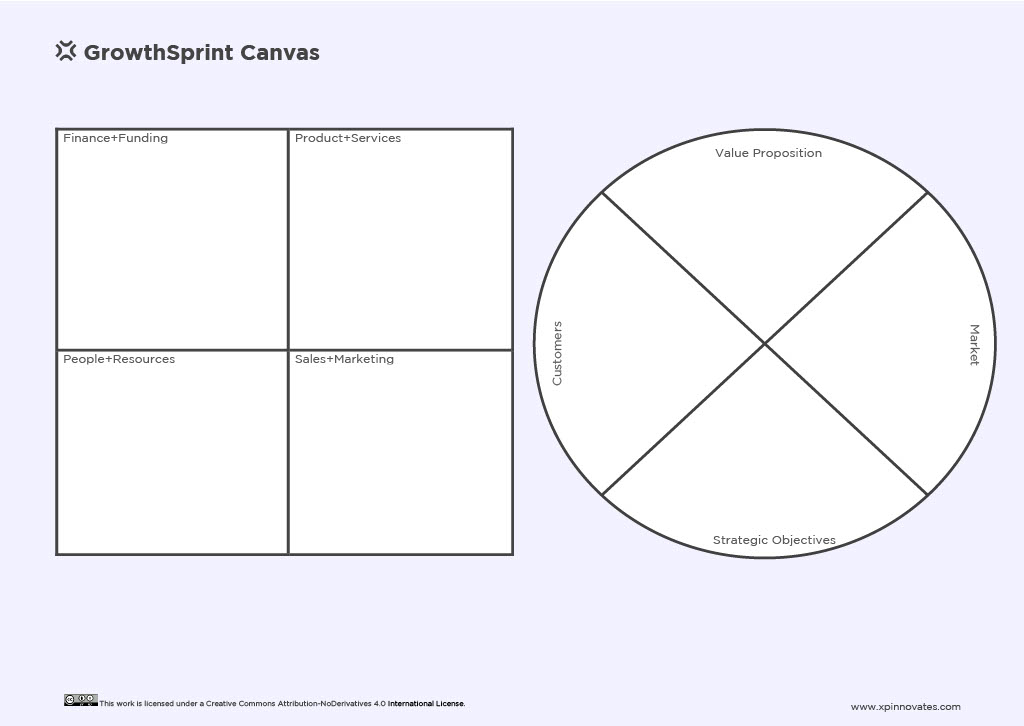When selling complex solutions to organisations it is imperative to understand your buyer's mode. Not…
Accelerate Your Business Growth: Mastering The GrowthSprint Canvas
The GrowthSprint Canvas is a new and unique business innovation tool. The canvas combines a series of steps to help you think through and build out a carefully crafted and collaborative growth strategy plan. This is the result of an XPinnovates lockdown project.
Who can use the GrowthSprint Canvas?
The canvas can be used by any firm looking to establish clear plans to grow. From start-ups, and scaling companies to SMEs. We designed the canvas and prototyped its final outline with a number of our clients. We’ve designed it to have a universal application.

The development of your strategic objectives is an agile process. It needs to be reiterated as you walk through and use the canvas.
Conventional business planning thinking usually includes an approach where you set business goals and develop strategies to obtain them. Once complete, a planning exercise takes place and is documented in a finished business plan.
The critique of this approach to business planning is clear. By the time you have gone through this process, it will become obsolete. Often the business planning process is carried out by a narrow team, and do not integrate a wider pool of staff to give their input.
How does the GrowthSprint Canvas work?
In broad terms, the right side of the canvas focuses on what takes place largely outside of your firm. It’s here where you need to fully understand your customers and the market you both operate in.
Who are your customers?
- How do your customers buy – what process do they experience?
- Is there a budget controller?
- What role does your typical contact have?
- How did they find out about you?
- What other like products do they procure.
- As much as you can find out about them the better, and start to build out a customer persona.
Do you know your market?
If you’ve been operating within a market for a decade or you’re just starting out it is imperative that you spend time researching the macro environment of your market.
Once done, the next step is to build an understanding of your market. You need to explore aspects like;
- Get a gauge on your competition- understand their products, their clients, and their pricing.
- Carry out a basic PEST analysis – what’s happening politically and legally?
- What social trends are affecting your business?
- Are there any key economic indicators that will affect any part of your business?
- Identify environmental issues that impact your customers and your operation.
This task may seem a little like ‘business 101’, but too many firms give too little attention to this key dataset. It’s here where you need to acquire data and evidence. Why? Because you need to constantly monitor the market and react when necessary.
Develop your Value Proposition
With a grasp and analysis of your customers and your market, now it is time to develop and articulate and calibrate strategies. Your value proposition has a strong fit with your chosen target clients. It needs to be robust enough to beat your competitors.
A value proposition is a promise of value to be delivered, communicated, and acknowledged. It is also a belief from the customer about how value will be delivered, experienced and acquired. It is a prospectus of a company that gives the customer the reason to choose their product or service.
Set out your Strategic Objectives
You can always start with this task, but it might be better to complete this now. Once you have explored your customers and articulated a value proposition your strategic aims may be easier to develop or refine.
Remember objectives need to be realistic, obtainable, and have measurable targets, within a time frame.
Once done. Press the pause button and go over the right side of the canvas again. Give yourself actions. Actions to find out more. To gather more data. To speak to more customers. Always start with your customers first.
A business innovation tool that addresses planning for growth.
The left side quadrants help you look at what needs to be immediately addressed. These are four fundamental parts of your organisation. As business leaders, we need to assess each area and make actionable plans. These plans support the task you have on the right side of the canvas and help you achieve the growth plans you have sent out.
A growth strategy meets the critical need to plan actionable milestones that achieve business results.
When we work with our clients, we have always determined clear areas for milestones to be met in the four quadrants of the business. As an alternative to the Business Model Canvas, our canvas allows business owners to see a wider picture, and plan actions for growth.
If you do not plan and execute, a business model with great fit the customer and your value proposition has diminishing value over time.
Likewise, there is no benefit for a business to set out clear value propositions to match market needs, if they cannot operate a business that can effectively sell and deliver the right services and products, in a financially viable manner. As business leaders, we all want to experience that moment of synergy, where your strategic aims are aligned with the operation of the business.

The GrowthSprint Canvas, however, allows you to take into account the status of your business. Firstly, assess each quadrant of your business – Finance, People, Product, and Sales. Plan how each function of your business will be affected by your newly set approach to growth.
Assess your current business status
Obtain a fully clear understanding of each quadrant of your business. These are sample questions you might ask in this analysis. Consider how each assessment may affect the other function.
Finance and Funding
Finances include any payments, accounting, loans, tax, and cash management in your firm.
- Full disclosure on cash balances and profit, this year and last, and forecasting.
- What will we alter in our finances to improve future profitability?
- Do you need to revise pricing or cash management?
- What are our current tax obligations?
- Do any plans require we draw on new investment or future bank lending?
- What list of actions need to be addressed to ensure your future plans are financially viable?
People and Resources
When we talk about people, we are talking about any human resource you have control over, they may be an employee or a contractor.
- How would we evaluate our current team make-up?
- Do we have the right balance of skills and culture?
- What are any obvious resource gaps you experience across your firm?
- Where do you typically fall down with people?
- What do we need to get the right balance of skills and expertise to deliver your future plans?
- Do we need to recruit, or indeed reduce staff numbers?
- Should we take in external advisors or add a non-exec board member?
- What actions will we put in place to align our human resources to meet our growth aspirations?
Product and Services
These are the services, and products that you develop and sell. This is the key area in your firm where value is conveyed to your customers.
- With our selected new growth strategies will our product portfolio require changing?
- Are there products that might be considered for scrapping?
- How is the profit contribution/revenue distributed across your portfolio?
- Will the supply chain be affected?
- Is this a time to review suppliers?
- Do we need to update or introduce new products into our portfolio?
- What investment or funds are needed?
- Do we need to consider bank lending? Can we get tax credits for R&D?
- What actions do you now need to put in place that support your value proposition and strategic objectives?
Sales & Marketing
The function and activities that you carry out to promote and acquire new (and retain) customers.
- How are your current sales and marketing processes working?
- Are there areas for improvement that you have been putting off?
- Are you making enough of digital tools to market and manage the pipeline?
- What actions do you now need to put in place to ensure our growth plans are feasible?
Sales and marketing are a core and central part of any business’s success.
Wrongly it is an area omitted from many business innovation model frameworks.
Whilst plans do not make for a strategy, to achieve your set of business goals and targets, a firm needs to combine the strategy setting process with a plan of activities that will support it
The canvas can be used by any firm looking to establish clear plans to grow their business. From start-ups, and scaling companies to SMEs. We designed the canvas and prototyped its final outline with a number of our clients, including a SaaS technology firm with eight years of track record, an early concept stage start-up looking to break into the online gifting sector, and, a company looking to be acquired.
Get in touch to find out how we can assist you set out your growth plans.
Note: This work is licensed under a Creative Commons Attribution-NoDerivatives 4.0 International License. You can also check it out on MIRO.



